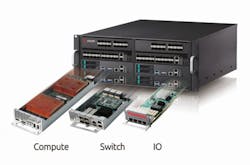Cloud Computing: Optimizing data collection and processing
Organizations are collecting more and more big data and consequently face challenges in using it effectively. “Just because we are collecting more data doesn’t mean we are getting more value from our data,” said Mike Santori, National Instruments business and technology fellow, speaking at NIWeek in August. “In the past, a lot of data was dumped to hard drives and sat there unused, just in case it was ever needed. That’s not going to cut it anymore.”
The cloud offers storage and processing options yet presents challenges of its own. Santori was speaking as the moderator of an NIWeek panel on big data, and other participants weighed in on the challenges. For example, Michael Schuldenfrei, CTO of Optimal+, said that an effective analytics strategy depends on obtaining consistent and high-quality data. Mark Potter, senior vice president and Enterprise Group CTO at Hewlett Packard Enterprise (HPE), cited the shortcomings of traditional database models and a need for a common architecture that nondatabase experts can access. Andy Timm, CTO of PTC, said an effective IoT solution extends beyond hardware and software toward tight integration with gateway providers.
A crucial question is where processing should take place. Potter said it must be possible to process data at every layer—some applications require rapid response and can’t afford the latency of cloud-based processing.
To that end, at NIWeek HPE highlighted its new Edgeline EL1000 and Edgeline EL4000 converged systems for the IoT. The latter will accommodate up to 64 processor cores. Both systems integrate data capture, control, compute, and storage to deliver analytics at the edge to enable real-time decision making. HPE said the systems would see applications in oil and gas, manufacturing, and telecommunications industries.
And in related news, HPE announced in June an agreement with GE Digital, under which HPE will be the preferred storage and infrastructure supplier for GE’s Predix cloud-based platform-as-a-service for the industrial IoT. At the time of the announcement, HPE’s Potter said, “HPE is uniquely positioned to provide the necessary hardware, software, and services to implement the advanced technology infrastructure required for GE’s Predix.”
Courtesy of ADLINK Technology
Electronics manufacturing platform
Also at NIWeek, Optimal+ introduced Release 6.5 of its flagship software, which includes an extension of the company’s Global Ops solution to serve the needs of electronics manufacturing operations. The company said Global Ops for Electronics is the foundation of a comprehensive platform for electronics companies developing end-market products (smartphones, networking servers, data servers, or automotive systems such as ADAS or car-to-X systems) to collect, analyze, and act on manufacturing and in-use data across a distributed supply chain.
“Modern electronics products are manufactured using a very broad and customized range of technologies,” said Dan Glotter, founder and CEO of Optimal+. “A typical electronics company may use hundreds of customized functional test systems to test products. Companies need to leverage the massive amount of data they are generating from these test systems to improve product quality and lower cost.” He added that NVIDIA, an early adopter of Optimal+ solutions for its semiconductor manufacturing operations, collaborated with Optimal+ on the design of the new Global Ops for Electronics solution.
“NVIDIA creates products, services, and software for the virtual reality, artificial intelligence, professional visualization, and automotive markets,” said Keith Katcher, vice president of operations engineering at NVIDIA, in a press release. “Global Ops for Electronics provides our product teams with complete visibility into our PCB and systems manufacturing processes. It enables us to rapidly identify and respond to the source of any issue, down to an operation, facility, line, or station.”
IBM also was on hand at NIWeek to highlight its Watson IoT platform. The company teamed up with NI to demonstrate the IBM Bluemix cloud platform and NI InsightCM Enterprise with applicability to the Industrial Internet Consortium’s Condition Monitoring and Predictive Maintenance Testbed.1 InsightCM Enterprise is a software solution for online condition monitoring with specially designed hardware options for asset health monitoring.
Joint lab facilities
Since NIWeek, other companies have addressed cloud applications as well. For example, ADLINK and Wind River in late August announced the establishment of joint lab facilities in Shanghai, China, and San Jose, CA, to promote the adoption of Network Functions Virtualization (NFV) for the telecommunications industry. The R&D centers will feature Wind River Titanium Server software running on ADLINK’s hardware platform based on the Modular Industrial Cloud Architecture (MICA) open framework. The combination of technologies will offer a platform for software manufacturers, system device suppliers, and service providers to test software rapidly through preliminary platform verification and system optimization, thus accelerating the application of NFV in the communications industry.
Wind River Titanium Server is a complete, commercial NFV infrastructure software platform that delivers carrier-grade reliability and performance for NFV applications. By integrating Titanium Server with ADLINK’s hardware platforms, NFV can be achieved at the network edge or in the data center, providing users with greater opportunities to maximize the performance and capacity of their NFV implementation and reduce operating expenses. With Titanium Server as a software foundation, the industry can accelerate its NFV goals while ensuring carrier-grade uptime and strict reliability mandated by telecom networks.
ADLINK in March released its MICA open framework (see image), which employs a modular design to achieve software-defined networking and NFV along with integrated hardware acceleration technology to speed up the processing of network data packages and video streaming. All functions have been integrated into the open computing structure, satisfying the key requirement of the cloud-computing era for resource distribution on demand.
“ADLINK is dedicated to promoting the development of the mobile telecommunications industry,” said Jim Liu, CEO of ADLINK, in a press release. “By creating a new-generation ecosystem of NFV-optimized, interoperable, standard solutions with Wind River, we can help to accelerate product time-to-market for ISPs and time-to-deploy NFV infrastructure for telecommunication device manufacturers as well as promote rapid, low-cost function upgrades in the future.”
“In order to make tangible progress toward NFV adoption, it is essential to collaborate across a wide ecosystem,” added Charlie Ashton, senior director of business development for networking solutions at Wind River. “Together with ADLINK, we’re providing opportunities to accelerate the testing and deployment of NFV solutions. With Wind River Titanium Server as a software foundation delivering carrier-grade virtualization for the NFV infrastructure, service providers can gain new flexibility and scalability while achieving significant improvements in operational costs and energy usage.”
A representative of China Mobile added that the NFV mode allows the use of inexpensive server hardware while enabling operators and enterprises to deploy or update services faster and more economically—completing large-scale, network-exclusive hardware updates across vast geographic areas within weeks or months.
IT for engineers
And finally, TotalCAE, which describes itself as “the IT Department for Engineers,” announced in September a high-performance computing (HPC) private-cloud appliance for speeding up simulations using Converge computational fluid dynamics software from Convergent Science.
The TotalCAE HPC Cluster Appliance for Converge eliminates the need to know Linux or complicated batch scheduler commands. All interaction with the appliance is through a simple-to-use web browser that requires just two clicks to solve.
TotalCAE manages the TotalCAE appliance, Converge software, Converge license manager, and cluster middleware in the customer data center, eliminating IT barriers to adopting HPC for Converge through a single dedicated IT team to keep engineers productive.
“Thanks to TotalCAE’s private and public cloud solutions, Converge users can take advantage of high-performance computing to efficiently run high-fidelity simulations and thus maximize the value that our CFD software provides to their engineering team,” said Daniel Lee, Ph.D., vice president and co-owner, Convergent Science, in a press release.
“TotalCAE enables our clients to reduce time to market by eliminating the cost and complexity of moving from engineering workstations to a HPC environment to reduce simulation time. The entire appliance is proactively managed top to bottom by TotalCAE, allowing the engineer to focus on doing engineering and not worry about IT issues,” added Rodney Mach, CEO of TotalCAE.
Reference
- Smith, J., and Matthews, S., “Introducing the Condition Monitoring & Predictive Maintenance Testbed,” Industrial Internet Consortium, July 21, 2015.
For more information
- ADLINK Technology
- Clutch
- Convergent Science
- GE Digital
- Hewlett Packard Enterprise
- IBM
- National Instruments
- Optimal+
- Renovatio Cloud Solutions
- TotalCAE
- Unleashed Technologies
- Wind River
SMBs adopt cloud hosting
Cloud hosting is an overwhelmingly popular option among small- to medium-sized businesses (SMBs), as shown by a new survey from Clutch, a B2B research firm. “2016 Cloud Backup Survey: Opinions and Usage” indicates that nearly 95% of SMBs report they either already use a cloud-hosting service or plan to transition to it.
Clutch says that according to industry analysts, the survey findings indicate that the transition to cloud hosting services is a good strategic move for SMBs.
The firm quotes Rachel Bair, director of hosting and client services at Unleashed Technologies, as saying, “I don’t think you can truly move forward within a company without using cloud in some way, whether that’s by buying software as a service from somebody or creating your own cloud infrastructure for your business. To stay competitive in your own business, cloud hosting will be the way to go.”1 Unleashed Technologies offers a service called Wosting, which it describes as drawing on its web and hosting expertise.
Courtesy of Clutch
The move to cloud hosting falls in line with a general trend of data migration within the web-hosting sphere. About 72% of SMBs say they changed web hosting providers at some point within the past five years. The largest percentage of those SMBs switched providers because they found a better value elsewhere.
“Data migration is mostly because of the commoditization of hosting,” added Bair. “Every year there are more and more providers for hosting, which creates more options. And as these competitors come into the marketplace, the offers and pricing tables are more robust.”
SMBs may be increasingly attracted to cloud hosting providers because of the difficulties they associate with web hosting. Eighty-six percent of SMBs surveyed had experienced an issue with their web-hosting provider in the past year alone.
Industry experts emphasize that web hosting is a highly technical field and can be a challenge for those who don’t have the requisite background knowledge. Without skilled technical personnel making decisions, a business can easily run into issues.
Clutch quotes Osman Seyrek, CEO at Renovatio Cloud Solutions, which offers cloud application development and IoT services, as saying, “[Web hosting] has a very large selection of technical offerings … so the customization and setup process is not simple if you have no idea what you’re expecting from those services. I’m assuming that the 14% [who didn’t experience an issue] are the ones who had technical capabilities to estimate their needs and make the right choices from the beginning.”
The Clutch survey included 300 SMBs with two to 1,000 employees. Sixty-eight percent of the companies surveyed have 200 employees or less.
Reference
- “Over 90% of SMBs use cloud hosting or say they plan to,” EE-Evaluation Engineering Online, Aug. 17, 2016.
About the Author

Rick Nelson
Contributing Editor
Rick is currently Contributing Technical Editor. He was Executive Editor for EE in 2011-2018. Previously he served on several publications, including EDN and Vision Systems Design, and has received awards for signed editorials from the American Society of Business Publication Editors. He began as a design engineer at General Electric and Litton Industries and earned a BSEE degree from Penn State.


